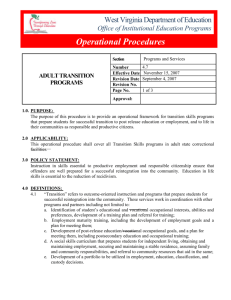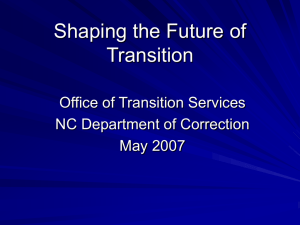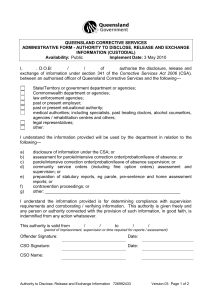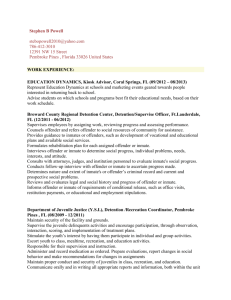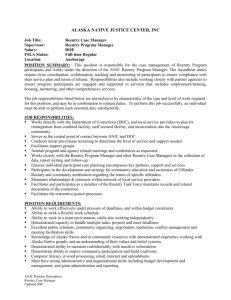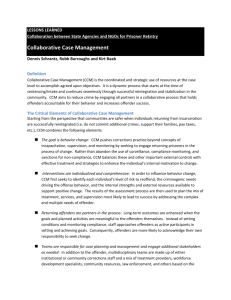ReEntry PowerPoint Presentation
advertisement
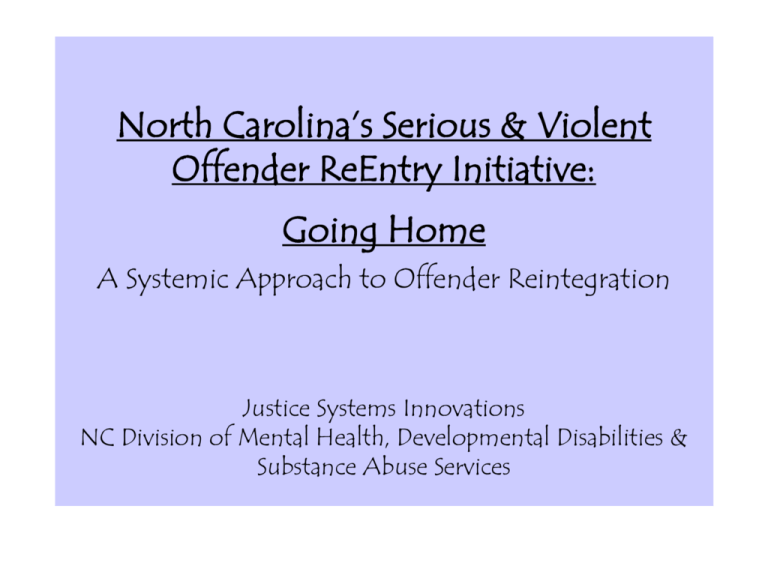
North Carolina’s Serious & Violent Offender ReEntry Initiative: Going Home A Systemic Approach to Offender Reintegration Justice Systems Innovations NC Division of Mental Health, Developmental Disabilities & Substance Abuse Services Going Home Initiative Goals • To ensure public safety by reducing recidivism through successful community reintegration. • To create a sustainable transition & reentry process that ensures coordinated services & supervision for offenders released from prison. • To establish a statewide network of government agencies, community & faith-based organizations, businesses & citizens committed to successful offender transition & reentry. NC Reentry Cluster Communities Region 3 Mitchell 24 Yancey 24 Madison 24 30 Graham Cherokee 30 Clay 30 Swain 30 Haywood 30 Jackson 30 Macon 30 Buncombe 28 Henderson 29 Transylvania 29 Surry 17 Wilkes 23 Yadkin 23 Avery 24 Caldwell 25 McDowell 29 Burke 25 Caswell 9 Rockingham 17 Forsyth 21 Guilford 18 Alexander 22 Iredell 22 Catawba 25 Stokes 17 Davidson 22 Rowan Polk 29 27 Cleveland 27 Gaston Orange 15 26 Mecklenburg Union 20 Lee 11 19 Stanly 20 Montgomery Anson 20 Moore 20 Richmond 20 Northampton 6 6 Halifax 9 Franklin Hoke 16 7 Edgecombe 2 Martin 3 Pitt 1 Gates 2 Washington 2 Beaufort 8 Greene Johnston 11 Harnett 11 6 Hertford 6 Bertie Wilson 7 8 Wayne 8 Lenoir 3 Craven 4 Jones 12 Cumberland Sampson 4 16 Scotland Robeson 16 7 Nash Wake 10 19 Cabarrus 19 9 Warren Granville Chatham 15 Randolph 19 Region 1 9 Vance 9 Davie 22 Lincoln 27 Rutherford 29 Person 9 Durham 14 24 Watauga Region 4 Alleghany 23 Alamance 15 23 Ashe Region 2 Duplin 4 13 Bladen Pender 5 13 Columbus 13 Brunswick New Hanover 5 4 Onslow 3 Pamlico 3 Carteret 2 Tyrrell 2 Hyde Dare 1 North Carolina’s Offender Re-entry Process Phase 1: Division of Prisons Phase 2: Community Reentry Phase 3: Long-term Support •Make a plan for the offender’s reentry •Ongoing review & monitoring of the offender’s reentry plan •Long-term accountability for reentry plan •Participate in programs such as education, substance abuse & mental health treatment, life skills & job training •Participate in programs for needed services, such as supervised housing, job placement, education & treatment Offender Management Model (OMM) •Participate in aftercare treatment, ongoing mentoring, & support groups via community-based organizations Clinical Assessment Individualized Case Plan Mental Health Services Employment Transportation Substance Abuse Svcs CBI Medical Services Education/ Voc Training Housing/Food/ Clothing Continuous Case Management and Case Staffing Target Population • Released from prison with at least 90 days of community supervision (e.g., parole or post-release supervision) • Age 18-35 at time of release • Going home to one of the cluster communities (see map) Target Population Profile Variable Crime Group Crime Category Western Public Order (56%) DWI (50%) Assault (20%) Wake/Durham Personal (73%) Robbery (37%) Assault (23%) Race Age Group 18-21 22-27 28-35 Reading Level (median) DART Assignment SMI Diagnosis White (65%) Black (81%) Eastern Personal (57%) Assault (27%) Robbery (23%) DWI (23%) Black (75%) 11% 37% 52% 8.3 – 8.8 13% 49% 38% 9.8 – 10.2 14% 37% 49% 9.3 – 9.8 76% 57% 57% 9% 5% 8% Phase 1: Institution • Plan for the offender’s reentry • Participation in programs such as academic & vocational education, substance abuse, & life skills • Work on the unit or through work release, or participate in vocational programs or job training • Receive medical & mental health treatment as needed Institution Process • Generate list of eligible inmates 12-15 months prior to release • Review list, verify eligibility, & contact case managers • Discuss Going Home Initiative & schedule initial meeting Institution Process (contd) • Review inmate’s file • Conduct Team meeting w/ Case Manager & Inmate (w/in 12 mos.) • Complete needs assessment, OTI & Common Assessment • Modify case plan • Conduct Team meeting w/ Case Manager & Inmate (w/in 6 mos.) • Review case plan • Make recommendations for conditions of release • Conduct Team meeting with Case Manager & Inmate (prior to release) • Review case plan & make initial recommendations for community case plan • Develop release schedule Intended Outcomes • Improve coordination of program & service delivery in prison • Identify transition & reentry needs earlier • Increase accountability for expected outcomes • Institute an outcome-oriented case planning process • Initiate a seamless transition from prison to the community DOC Programs, Policies & Procedures • Education (academic & vocational) • Vocational Rehabilitation • Drug/Alcohol Recovery Treatment (DART) • Character Education • Transition Aftercare Network (TAN) • Employment (Work Release, Corrections Enterprise) • Cognitive Behavioral Interventions (CBI) • JOBSTART/JOBSTART II (Job Preparation for Offenders) • Mutual Agreement Parole Program (MAPP) • New Case Management policy • New Transition policy • Transition Envelope Phase 2: Community Reentry • Ongoing review & monitoring of offender’s reentry plan • Participate in programs for needed treatment & services, such as supervised housing, job search & placement, academic & vocational education & treatment • Develop mentoring relationship & supportive networks Community Process • Initiate 24-hour shadow (community mentor) • Establish basic support system • Begin probation supervision • Develop community case plan with expanded Transition Team • Monitor case plan • Participation in programs & services • Focus on housing, employment & mentoring • Continue on-going case management Intended Outcomes • Re-assess offender for risk & need • Monitor outcome-oriented case planning • Increase accountability for expected outcomes • Improve program & service delivery system in the community • Emphasize specific transition issues such as housing, employment, mentoring & treatment Phase 3: Long-term Support • Identify goals for longterm accountability • Participate in continuing care, mentoring & support groups • Continue monitoring of reentry plan Long-term Process • Provide supportive network for offender • Build capacity of community partners to provide supportive network for offenders • Promote and cultivate relationships among network partners • Conduct training and provide technical assistance and workshops Intended Outcomes • Establish long-term support & networks in the community • Build capacity of communities to hold offenders accountable • Build capacity of community-based organizations to support offenders in transition • Share accountability for expected outcomes Keys to Offender Reintegration An interlocking process involving the correctional system w/ state & local partners: Pre-release planning & preparation Post-release transitioning & supervision On-going community support Close supervision from day of release through transition by probation/parole officers, in concert w/ local law enforcement & community-based partners, is essential for keeping the offender focused on his/her reintegration case plan. Post-Release Supervision • Close supervision monitoring of the offender from the day of release through the end of the transitional phase by probation/ parole officers, in concert with local law enforcement & other community-based partners. • This is crucial to keeping the offender on task in pursuing his or her reintegration case plan. The Four C’s of Partnering Collaboration A spirit of willing cooperation & mutual respect that allows different entities to share a common vision to contribute to the process. Coordination A sequenced plan of action, agreed to by all parties, delineating who will do what, when & for what duration. Commitment A good-faith pledge by all partners to do whatever each has resources to do, with no concern for who gets credit. Communication The free sharing of information and knowledge. 5. Reintegration Culminates in the Community • The ultimate challenge of the reintegration process occurs in the community. • The community partners who will assume primary respons-ibility in this stage must be increasingly involved in the process as it progresses, ensuring continuity of support leading to offender reintegration. Objectives of the Local Partner Process • Increased understanding of the criminal justice system, corrections & offenders • Enhanced ability to respond to public safety issues, as well as community concerns • Integrated local resources & agency work • Enhanced problem-solving skills around common interests • An educated, diverse core group that can explain program & resource needs for system integration Local Partner Process: Critical Elements • Define a mechanism to facilitate two-way communication; All parties directly involved must be committed to the mechanism • Representation from all appropriate segments of the community • Define the roles & responsibilities of each partner • Direct involvement in decision-making process • Clearly defined procedures to hold each other accountable • Each partner’s needs & limitations are acknowledged & addressed • Orientations for all partners to learn about each other Local Partner “to do list” • Develop leadership structure • Develop regular meeting schedule • Develop local Memoranda of Understanding & standard operating procedures • Tour local prison & build relationships with staff • Conduct resource mapping in major need areas: housing, employment, mentoring/life coaching & treatment • Develop job description for contractual JobLink staff • Build network capacity by participating in training & requesting technical assistance
